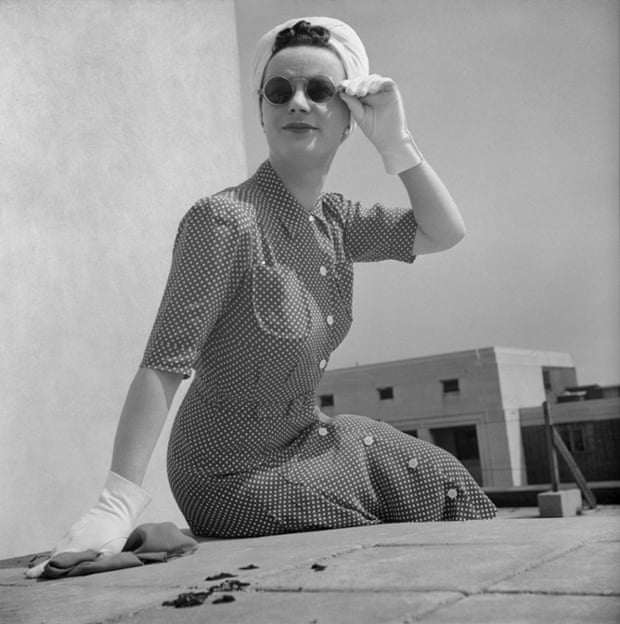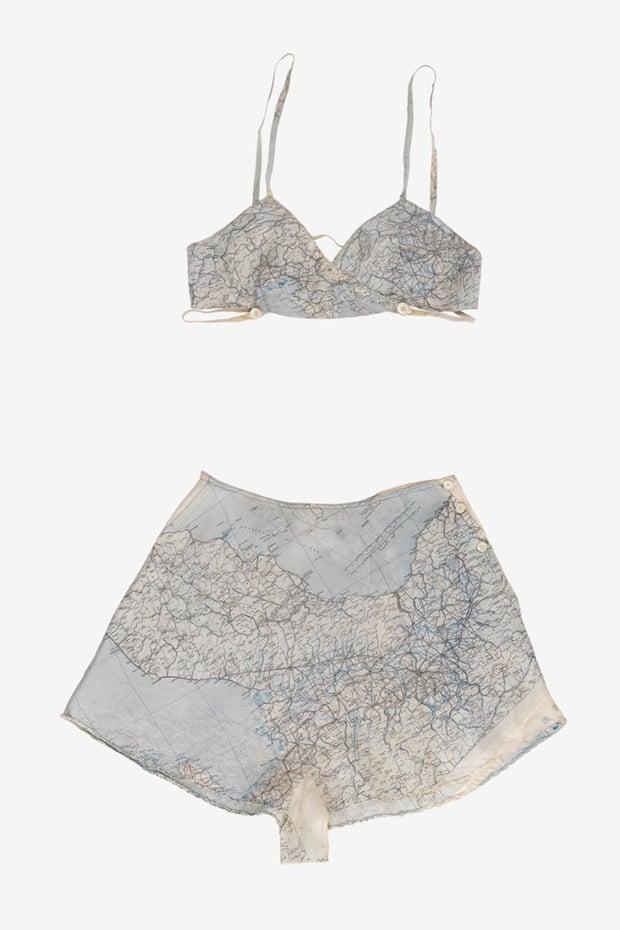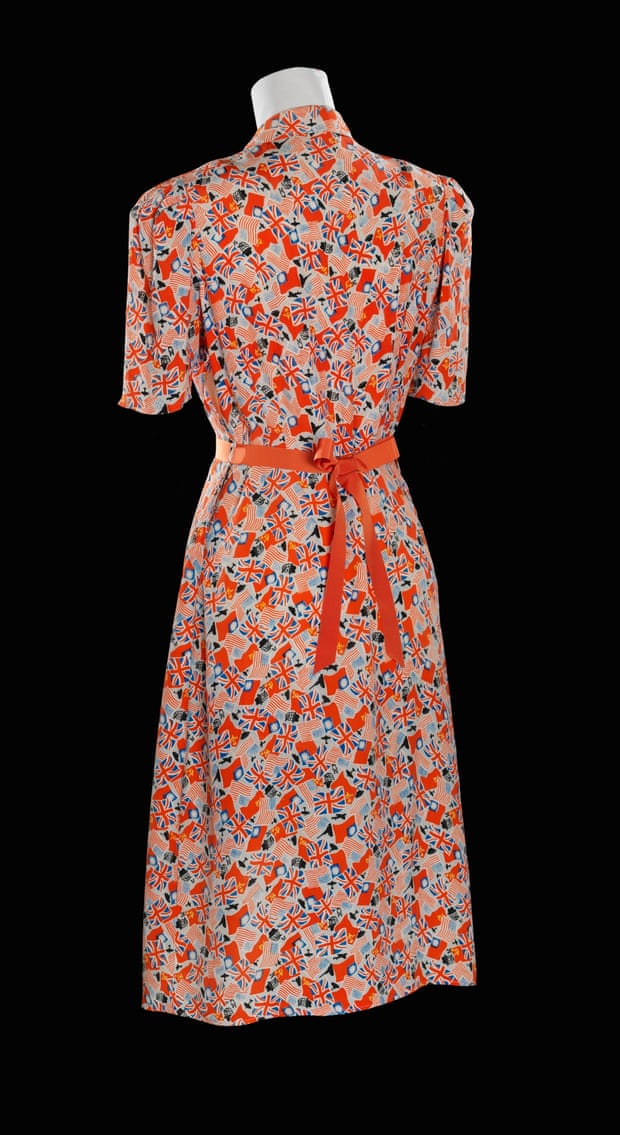-
Fashion on a Ration : Fashion during the Second World War

On 11 September 1939, Constance Miles of Guildford went up to town. Hitler or no Hitler, she needed a new winter coat. But as Mrs Miles made her way around the West End it was immediately apparent that something had changed in the eight days since war had been declared. People had stopped spending money on clothes, or at least on the sort of clothes that made a splash. At Swan & Edgar Mrs Miles glanced in at the “great evening dress department, all pretty models, with not one soul buying”.
That wasn’t the only thing that had changed. As she crossed Piccadilly Circus in search of her new winter coat, she would have noticed the large number of people who were already in uniform. Eventually a third of the adult population would be wearing khaki, navy blue, steel blue, forest green or one of the other colours of official service. It must have felt, suggests Laura Clouting, curator of the Imperial War Museum’s new exhibition Fashion on the Ration: 1940s Street Style, “as if the visual landscape had been transformed: even before the first bomb had dropped you were navigating the world differently”. As a civilian, one of Mrs Miles’s first tasks would be to learn how to read all these signs and markers of the new authority, to know who was a regular fireman, who was a volunteer, whose directions it was worth following, and whether it was a good idea to try flirting with the man in navy blue.
Utility clothing in Britain in 1943
Fashion on the Ration, then, reckons to tell a story that is more variegated and more joyous than the usual narrative about how women spent the second world war faking stocking seams with eye pencil to disguise the fact that their underwear drawer was denuded. Instead, the exhibition focuses on the ways that British people continued to take pleasure in looking good between 1939 and 1945, no matter how difficult the circumstances in which they were obliged to get dressed (often in the dark, sometimes with bombs falling, and always with some key item of clothing worn to the point of transparency).
The women’s auxiliary services were shameless in using clothes to catch recruits. Women’s Royal Naval Service (WRNS) officers were generally reckoned to have the nicest uniform: a stylish navy suit with a generously box-pleated skirt (no skimping on the fabric here), brass buttons and – a huge source of envy – coupons for good-quality black stockings. Joining the WRNS in 1943, the future novelist Barbara Pym was charmed: “My hat is lovely, every bit as fetching as I’d hoped … I also have a macintosh and greatcoat – three pairs ‘hose’ (black), gloves, tie, four shirts and nine stiff collars, and two pairs of shoes which are surprisingly comfortable.” For one working-class recruit, the comfort of the standard-issue shoes was less important than the sensation of owning “a pair that had never been worn before … I was so proud”.
“Pride” is a word that crops up often in the letters and diaries that appear in the exhibition as a commentary on all those knife-edge pleats, stiff collars and jaunty caps. “There is no doubt that ‘dressing up’ helps soldiers, as it helps actors, to play their parts,” reflected Hilary Wayne when she joined the Auxiliary Territorial Service. “I think we not only looked different, we felt different.” This was generous of Wayne since the shapeless khaki ATS uniform was generally agreed to be “hideous”. Such, anyway, was the verdict of Barbara Cartland, who had the bright idea of accumulating a lending library of white wedding dresses so that servicewomen would not be obliged to get married in “clumping shoes and a collar and tie”.
There were disappointments, though. The WRNS blazer turned out to be cut on such masculine lines that it pinched and gaped on anyone with a generous bust. The solution was to steam and stretch the fabric over your knee to produce an accommodating curve in the chest area. The 80,000 members of the Women’s Land Army, meanwhile, became known for more radical hacks. The fawn corduroy breeches that looked so dashing on freezing winter mornings felt clammy by July and, more to the point, stopped outdoor legs from getting a tan. The only thing to do was cut the trousers into a pair of micro-shorts and hope you weren’t due a kit inspection any time soon.
While women in the services worked hard to customise their clothes, those in mufti took pains to look as though they were wearing a uniform of their own devising. Jacket shoulders broadened and stiffened; hats shrunk to caps. Vogue urged its readers to swap their usual tweed skirts for trousers crisply cut by a male tailor (although only if they were under 50 years old and 10 stone). The glossy fashion magazine was allowed to continue publishing throughout the war despite paper shortages because the men from the ministry realised its usefulness as a conduit for delivering key messages about domesticity and consumerism to the women of Britain. Vogue’s well-heeled readers could be trusted to trickle down information through the networks in which they took a leading role, including the Women’s Voluntary Service and the WI.
Patricia Mountbatten’s underwear made from silk maps
One such intervention came early. As Constance Miles had discovered on her shopping trip to an empty Swan & Edgar, the declaration of war had made people put away their purses. This was a disaster for the economy, and Vogue stepped in to inform its readers that it was their patriotic duty to carry on restocking their wardrobes as if a weekend on the slopes in St Moritz or an early spring break in St Tropez lay right around the corner: “Every time you hold back from buying, you knock the national economy a fraction off its balance.” To bring the rest of its editorial message into line, the magazine now rowed back from its initial suggestion that a pair of well-cut mannish trousers was all a woman needed to look stylish in this transformed universe. Readers were now sternly warned against becoming “slackers in slacks” – the sort of scruffy hoydens who made everyone else feel like giving up, too. Cultivating “the arts of peace” – a pretty dress, a new perm – had become a kind of public service.
With Vogue’s orders ringing in their ears, the women of Britain fell to shopping. New rhythms of living had opened up a demand for novel categories of clothing, which manufacturers were only too happy to fulfil. One of the most striking objects in the exhibition is a siren suit, a 1940s version of a onesie that you pulled on over nightclothes as you scrambled for the shelter. Made in fine navy wool, it is artfully tailored to make the most of the wearer’s waist, while the flared trousers skim tactfully over the thighs. A cowl hood, contrasting piping and detachable belt add panache and the overall effect is to make you look as if you are attending a slightly chilly cocktail party rather than about to spend the night in a burrow at the bottom of the garden.
Accessories bloomed in strange new shapes. Rather than carry your gas mask around in its standard cardboard case with a drab string handle, you could opt for the Arden pigskin holdall from Fenwick at 5½ guineas (about £320 today). Constance Miles got something similar from her husband Robin as a present, while the exhibition includes an item that manages to be a remarkably stylish hybrid between a smart clutch handbag and a carrying case. Selfridges, meanwhile, did an imaginative line in luminous accessories – buttons, brooches, hat fancies – designed to ensure that you showed up safely in the blackout as you trudged home, having given up on the bus.
It was not until June 1941 that clothing became subject to formal rationing. With fabric increasingly required for service uniforms, not to mention camouflage, blankets, oil cloths and a hundred other military uses, civilians were now limited to one new outfit – eg 66 coupons – a year. Churchill hated the principle, convinced that reducing the nation to living in “rags and tatters” would have a devastating effect on morale. But the legislation was driven through by Oliver Lyttelton at the Board of Trade who believed – correctly, as it turned out – that rationing would allow the poorest sections of society to get a fairer share of the dwindling number of clothes available in the shops. Lyttelton devised a fiendishly complex new paper economy by which each garment, and every bit of cloth, was deemed to be “worth” a certain amount of labour and material. Fourteen coupons got you a new winter coat, seven a dress, while three were needed for a pair of knickers.
Back of printed rayon crepe dress
Only those who had started off the war extremely well-provisioned – Henry “Chips” Channon, the Tory MP and diarist, had 40 suits that he reckoned would keep him going through any apocalypse – felt properly provided for, although even Channon admitted to feeling worried about his sock situation. It was now that the government launched its Make Do and Mend campaign, which included a jolly primer about how to unpick old jumpers and knit them up into something smarter or how to create “decorative patches” from worn-out garments to cover holes in only slightly less exhausted ones. Flo Hyatt, a typist working for the Cereals Import Committee, described her weekends to her US cousins as “usually spent darning and patching and soon some of the things will be more darn and patch than anything else”.
Those who were more confident in their needlework – and virtually every woman would have learned the basics at school – regularly managed miracles. One of the most stunning objects in the exhibition is a woman’s grey pinstripe “costume”, consisting of a smartly tailored jacket and skirt, that has been fashioned from a man’s suit. It is a wonder of elegant repurposing. Meanwhile, a girl from Yorkshire writes casually of making a “woollen edge-to-edge coat … for a couple of seasons. Next I put buttons and buttonholes and used a fur collar from another coat. Another season I took out the lining and made it into a button-through dress using a white lace bow at the neck. After that, I made it into a skirt.”
The most unlikely fabrics were pressed into service. Military maps were often printed on silk and, equally frequently, found themselves out of date and surplus to requirements. It was from just such material – given to her by a boyfriend – that Patricia Mountbatten had pretty new underwear fashioned, including a set of cami-knickers and bra. Less fortunate women found themselves trying to outwit more obdurate material. Draughtsman’s paper could, in theory, be boiled down into cambric and then refashioned into pants. There was naturally some residual stiffness, although it was nothing like as bad as the rustling “passion killers” or “boy bafflers” that were standard issue for women joining the uniformed services.
The great revelation of Fashion on the Ration comes relatively late in its timeline – halfway through, in fact. It was in the spring of 1942 that austerity measures, complete with the “Utility” mark, were brought into being. The name conjured up – and still does – the idea of a civilian population walking around in drab tat. In fact, as the exhibition shows, Utility clothing was mostly a triumph of deft and elegant design. True, men were no longer allowed to have turn-ups on their trousers, women’s skirts were short and sleek, and socks were only nine inches long, but the result was a pared-down aesthetic that has stood the test of time far better than fussier clothing from earlier in the war.
This was because the Utility wardrobe was designed not by the likes of Churchill and Lyttelton, nor even by the journalists at Vogue, but by a specially mustered consortium of fashion designers consisting of such luminaries as Norman Hartnell, Hardy Amies and Edward Molyneux. The result was a capsule wardrobe consisting of clothes that many women would be happy to wear today (assuming, that is, they are a size 8 – if the museum’s mannequins prove one thing, it is that bodies really have changed in the past 70 years). Stand-outs include a wonderful mustard wool-coat dress from Alexon and some bright rayon tea dresses (colour was not rationed) that could easily take their chances today in Topshop. There’s even a teddy bear fleece coat with just the right kind of styling on the sleeves to stop it looking like fancy dress. No wonder that Amies and Molyneux liked to joke between themselves that “we have been making utility clothes for years”. It had taken a global war for the rest of Britain to wake up to the fact that dressing well was a matter of matching form to function, of working with the best materials available and resisting the desire to add pointless decoration just because you could. It was nothing less than modernism for the masses.
• Fashion on the Ration is at the Imperial War Museum, London SE1, from 4 March iwm.org.uk. An accompanying book by Julie Summers is published by Profile.
« ‘Kehinde Wiley: A New Republic’ at the Brooklyn Museum (NYT)Improve your memory : the POPCORN method! » Tags : fashion, WW2, The Guardian
Tags : fashion, WW2, The Guardian
-
Commentaires



